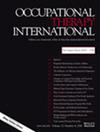Requirements for Universally Accessible Upper-Body Exercise Equipment: The Case of People with Spinal Cord Injuries in Korea
IF 0.9
4区 医学
Q3 REHABILITATION
引用次数: 0
Abstract
Background. People with disabilities face considerable obstacles when exercising, which precludes them from the social and health benefits of physical activity. Especially for individuals with paraplegia with spinal cord injuries, it is necessary to maintain continuous participation in physical activity even after discharge, as it helps to maintain mobility and daily living activities through upper body strength. However, the participation rate of people with disabilities in physical activity in Korea is still low, mainly due to the lack of exercise equipment and facilities. Objectives. The aim of this study is to identify aspects that can be improved for better accessibility to exercise equipment for individuals with paraplegia with spinal cord injuries and to reach a consensus on possible guidelines for accessible exercise equipment. Methods. This study reviews and evaluated the usability of four existing upper-body exercise equipment for individuals with paraplegia with spinal cord injuries. To assess usability, task performance scores and time were measured, and a survey was conducted on safety and satisfaction. Based on these results, areas for improvement were identified. Through literature review, usability results, and opinions from various stakeholders, eight requirements for universal accessibility were proposed. Results. It is necessary to consider how wheelchair users access the exercise equipment. The access method to the exercise area (facility regulations, auxiliary equipment to be provided, etc.) and placement of exercise equipment should also be considered. Information such as explanations of the exercise equipment and how to use it should be located within the wheelchair user’s field of vision. Considering the participation rate in sports for people with disabilities in Korea, it is necessary to explain the exact exercise equipment and exercise method. It is also necessary to consider how wheelchair users transfer from the wheelchair to the seat of the exercise equipment. Parts that require manipulation of each exercise equipment must be within the wheelchair user’s range of motion. Various supports or assistive devices that provide body support according to each piece of equipment are needed. In addition to the wheelchair’s own brake, it is necessary to provide a fixing device so that the wheelchair does not move during the exercise. Conclusion. For people with spinal cord injuries, the arm ergometer, aerobic exercise equipment, showed higher scores in performance, stability, and satisfaction compared to other exercise equipment. Among the strength exercise equipment, shoulder press had an effect on performance, seated lat pull-down had an effect on stability, and seated chest press had an effect on satisfaction. Therefore, when selecting exercise equipment, it is necessary to recommend aerobic and strength exercise equipment according to the preferences of people with spinal cord injuries. When developing strength exercise equipment, it is necessary to consider usability evaluation factors for individuals with spinal cord injury.对普及型上肢锻炼设备的要求:韩国脊髓损伤患者案例
背景。残疾人在锻炼时会遇到很多障碍,这使他们无法享受体育锻炼带来的社会和健康益处。尤其是脊髓损伤截瘫患者,即使在出院后也有必要坚持参加体育锻炼,因为这有助于通过上肢力量保持行动能力和日常生活活动能力。然而,在韩国,残疾人参加体育锻炼的比例仍然很低,主要原因是缺乏锻炼器材和设施。研究目的本研究的目的是找出可以改进的方面,以便脊髓损伤截瘫患者更好地使用运动器材,并就无障碍运动器材的可行指南达成共识。方法。本研究回顾并评估了四种现有上肢运动器材对脊髓损伤截瘫患者的可用性。为了评估可用性,测量了任务执行得分和时间,并对安全性和满意度进行了调查。根据这些结果,确定了需要改进的地方。通过文献综述、可用性结果和各利益相关方的意见,提出了八项通用无障碍要求。结果。有必要考虑轮椅使用者如何使用运动器材。还应考虑进入运动区的方法(设施规定、提供的辅助设备等)和运动器材的摆放位置。运动器材的说明和使用方法等信息应位于轮椅使用者的视野范围内。考虑到韩国残疾人的运动参与率,有必要对运动器材和运动方法进行确切的说明。此外,还有必要考虑轮椅使用者如何从轮椅转移到运动器材的座位上。每种运动器材需要操作的部分必须在轮椅使用者的活动范围之内。需要根据每种设备提供各种支撑或辅助装置,为身体提供支撑。除了轮椅自身的制动装置外,还需要提供固定装置,使轮椅在运动过程中不会移动。结论对于脊髓损伤患者而言,与其他运动器材相比,臂力器这种有氧运动器材在运动表现、稳定性和满意度方面的得分更高。在力量锻炼器械中,肩部推举对表现有影响,坐姿下拉对稳定性有影响,坐姿胸部推举对满意度有影响。因此,在选择锻炼器材时,有必要根据脊髓损伤患者的喜好推荐有氧和力量锻炼器材。在开发力量锻炼器材时,有必要考虑脊髓损伤者的可用性评估因素。
本文章由计算机程序翻译,如有差异,请以英文原文为准。
求助全文
约1分钟内获得全文
求助全文
来源期刊

Occupational Therapy International
REHABILITATION-
CiteScore
2.50
自引率
6.70%
发文量
121
审稿时长
>12 weeks
期刊介绍:
Occupational Therapy International is a peer-reviewed journal, publishing manuscripts that reflect the practice of occupational therapy throughout the world. Research studies or original concept papers are considered for publication. Priority for publication will be given to research studies that provide recommendations for evidence-based practice and demonstrate the effectiveness of a specific treatment method. Single subject case studies evaluating treatment effectiveness are also encouraged. Other topics that are appropriate for the journal include reliability and validity of clinical instruments, assistive technology, community rehabilitation, cultural comparisons, health promotion and wellness.
 求助内容:
求助内容: 应助结果提醒方式:
应助结果提醒方式:


